Cantilever parasol purchasing advice: how to choose the right product
- The most important facts in brief
- In contrast to a conventional parasol, a traffic light parasol does not have a disturbing centre pole. The large shaded area can be used completely.
- A characteristic feature of a traffic light parasol is that the pole is located on the side. The terms gallows umbrella, free-arm umbrella and side mast umbrella are also commonly used.
- There is a wide variety of shapes, sizes, materials, colours and designs.
- Rotation and tilt options allow sun protection throughout the day.
Enjoying sunny weather with a traffic light umbrella
When the sun appears in the sky, many people want to enjoy the nice weather in the garden. But no one wants to sit in the blazing sun – protection from the sun is indispensable. A traffic light umbrella provides pleasant shade and does not need a central pole that takes up space in the shaded area.
What are the characteristics of a traffic light umbrella?
A traffic light umbrella is a variant of the parasol. A characteristic feature of the construction of a traffic light parasol is that it does not have a centre pole. In contrast to a normal parasol, the shaded area does not rotate around the centre pole. The umbrella stand is not mounted in the middle, but offset to the side. The sunshade itself hangs on a very sturdy metal pole, which is also called a traffic light. This is where the name for this parasol model comes from. Various adjustment options (depending on the model) allow the sun to be shielded from different angles. This is advantageous if a sufficient shaded area is to be created over many hours.
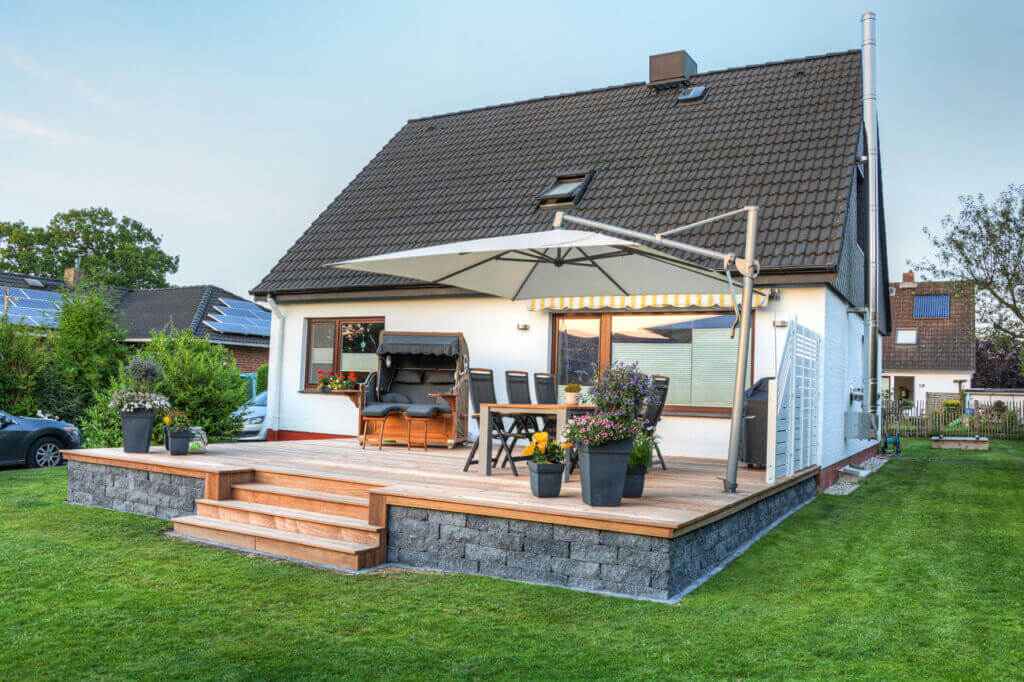
Traffic light umbrellas in cafés and restaurants
Traffic light umbrellas tend to be larger than normal parasols. This has the advantage that, depending on the model, a significantly larger shaded area can be used. The traffic light parasol was originally developed as a large-area solution for cafés and restaurants. In the commercial sector, it is a standard solution. But also in private households, a traffic light umbrella can be found more and more often.
How does a traffic light umbrella work?
Traffic light umbrellas are easy to operate. They are opened by hand using a simple mechanism. In most models, a crank in combination with a pulley ensures smooth opening and closing. Even large parasols can be stored in a space-saving manner when folded. Such a parasol is also space-saving in that it can be placed directly next to house walls or furniture. The operating elements are usually placed at seat height. The pole of the parasol is deliberately curved so that it can be kept out of the seating area as much as possible. Traffic light umbrellas can also be swivelled so that an individual inclination can be set with regard to the incidence of sunlight. The degree of inclination can be adjusted with the crank on some models. Free-standing and 360-degree swivelling traffic light umbrellas are very practical because they can keep the sun out at any time of day.
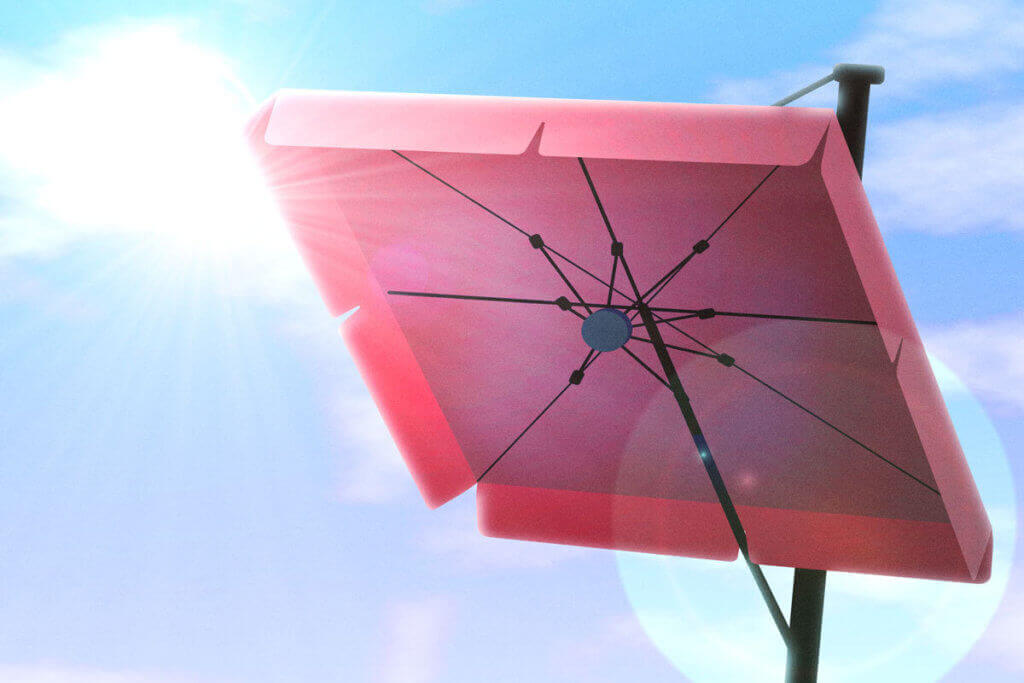
Why should I buy a traffic light umbrella?
A sunshade is indispensable for outdoor use in high summer. However, if you don’t want to buy a classic parasol because of the centre pole, a traffic light parasol is a good choice. The larger shaded area means that larger seating areas can also be wrapped in shade, while the airy design can make a visually enhancing contribution to the overall picture. Modern designs can be eye-catching. The advantages and disadvantages of a traffic light umbrella at a glance:
Pro points
- Disturbing umbrella branch in the middle is eliminated
- Large shaded area
- Can be used very flexibly or adjusted variably
- Tilting and rotating options effectively block the sun at any time of day
- Available in many sizes, shapes, materials & colours
Drawbacks
- Traffic light umbrellas prove to be more susceptible to wind
- A larger base or other fixation is necessary to provide the necessary stability.
Types and designs
Traffic light umbrellas have different shapes. Square, rectangular and round models are common. In addition to personal taste, the available space can speak for or against a particular shape. In terms of their basic construction, however, all traffic light umbrellas are similar. Irrespective of the shape, the traffic light umbrella always hangs on a stable pole.
There is a great variety in the materials that can be used for a traffic light umbrella. In general, the materials must be able to withstand various influences over a long period of time, with sunlight, wind and moisture being the most important. A look at the product descriptions of traffic light umbrellas shows that these three materials in particular are used very frequently:
- Polyester
- Acrylic
- Olefin
Acrylic fibres are most frequently used for the covering of traffic light umbrellas. They are very functional and do not provide a breeding ground for mould. This plays an important role for outdoor use. A high colour and light resistance also speak in favour of this material. As traffic light umbrellas made of acrylic are usually impregnated, the surface is water and dirt repellent as well as rot resistant. However, models with this material are the most expensive. On the one hand, this is due to the longevity, on the other hand to the fact that some manufacturers have patented their coverings.
Polyester is also a very functional, but somewhat cheaper option for the covering. This synthetic fibre is very dimensionally stable, but does not offer quite as effective protection against mould. In individual cases, it always depends on which protective impregnation a model has. If you are looking for a traffic light umbrella in the lower price segment, you will usually get a polyester covering. One disadvantage that has to be accepted is that the colours fade relatively quickly.
Finally, olefin is a very light material with excellent covering properties. It is ideally suited for traffic light umbrellas because it dries quickly and absorbs very little moisture. High-quality traffic light umbrellas with olefin are characterised by low colour loss. This material also proves to be suitable for outdoor use with regard to stains and weathering.
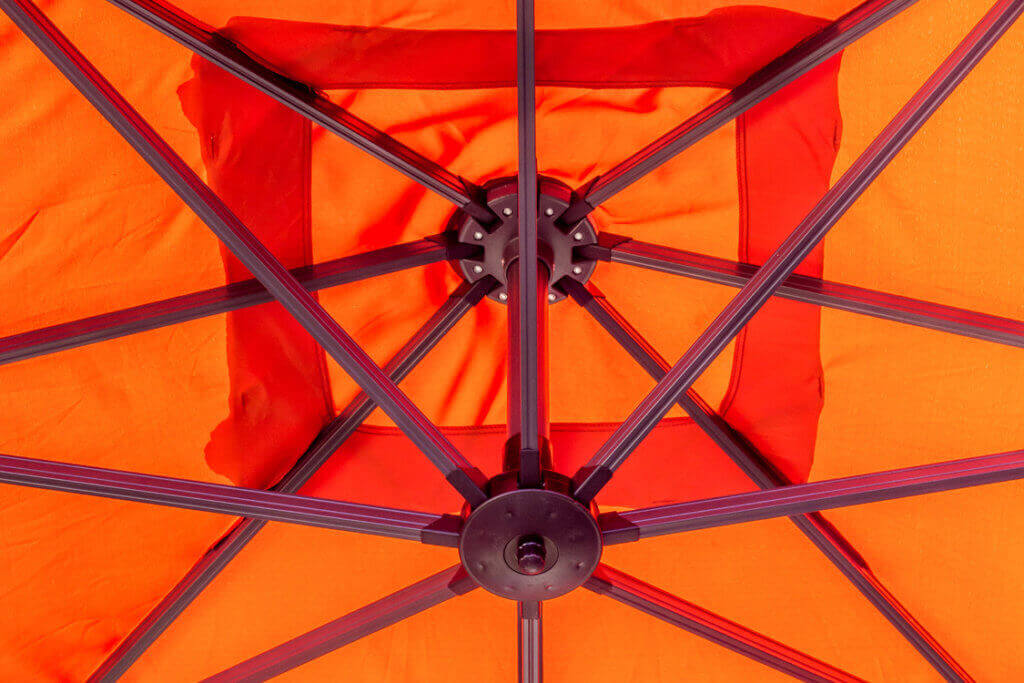
Often there are also fabric combinations. Blends are intended to combine the advantages of individual materials. Some manufacturers point out that the material mix has a direct influence on the quality of the impregnation.
The mast
Differences can be seen above all in the mast of a traffic light umbrella. The larger and heavier the umbrella, the more stable the mast must be. This results in different mast diameters. The materials used are mostly aluminium, steel and wood. Aluminium enjoys great popularity thanks to its modern look and light weight. Traffic light umbrellas with a wooden mast are ideal for creating a harmonious overall appearance if wooden garden furniture is already available. Steel and stainless steel usually have an additional powder coating to make the surface more resistant.
Stand and mounting
A traffic light umbrella must not tilt due to light wind or contact. Therefore, traffic light umbrellas are usually supplied with a heavy stand in the middle of which the pole is fixed. Filling with water or sand can provide more stability, especially for large models. The respective manufacturer’s description indicates up to which wind force the use of the traffic light umbrella is still permissible. With some models it is possible to fix the base (e.g. with ground nails) or even to set it permanently in concrete.
Other construction features
Some models have a wind valve and valances. The wind valve is recessed in the middle of the canopy and offers improved air permeability. If there are stronger gusts of wind, wind vents are very advantageous. They also noticeably improve the air circulation under the canopy.
Flounces are also found on awnings, for example. These are fabric overhangs that at first glance only look like an optical addition. However, they also serve to keep out particularly deep rays of sunlight.
A few models are equipped with a motor, which provides additional comfort. Most traffic light umbrellas, however, are operated manually by crank, whereby the necessary effort is kept within limits anyway. As far as the adjustment options are concerned, there can be significant differences depending on the price range. Particularly practical is the ability to rotate 360 degrees, which makes it possible to adjust the angle to the sun during the course of the day.
What to look for when choosing a traffic light umbrella?
It is important that the sunshade is easy to operate. Anyone who wants to enjoy shade on the terrace wants to be able to do so in just a few simple steps.
Basically, the following purchase criteria are important:
- Size of the shaded area
- Stability
- Structure
- Design
How much should a traffic light umbrella cost?
The prices of large umbrellas of attractive quality are in the low to mid three-digit range. Inexpensive models are already available for around 50 to 100 euros. If you value an unusual design and high quality, you have to look in the premium segment and pay a price in the mid three-digit range.
The materials
The frame in particular should be made of robust materials. Anodised aluminium is used for many models. As far as the coverings are concerned, you should attach importance to easy maintenance. Here, the material thickness comes into focus, which is indicated with the unit of measurement g/m². If you want to keep the sun out with an umbrella that is not only superficial, you should choose a model with a high UV protection factor (50 or higher). This allows you to spend several hours in the shade without worry.
In midsummer, even a short shower can never be ruled out. Models with water-repellent properties can keep the rain out. With them, there is no need to fold the umbrella immediately.
The different fabric classes
Parasol manufacturers often specify a fabric class in the product description. As a rule, the fabric classes I to V are found, whereby the last one represents the most robust material quality. The fabric class was introduced in order to be able to define the light fastness. With fabric class I, the first colour changes can be seen after about 40 days of exposure to strong sunlight. With class V, on the other hand, it takes over 700 days before the first effects of UV radiation are slightly visible.
Construction of a traffic light umbrella: a choice suitable for everyday use?
The crank and pulley ensure smooth comfort with good workmanship. With regard to this important purchase criterion, it can be useful to read reviews from customers. The traffic light umbrella should be easy to operate.
What should the new traffic light umbrella look like?
Of course, the new traffic light umbrella must also meet personal taste and fit seamlessly or deliberately strikingly into the existing picture. In this respect, too, there is a wide choice, as the market offers many different shapes and colours. Dark colours are recommended if very high UV protection is desired. As a rule, the lighter the colour, the lower the UV protection. But also the perceived blackout effect depends on the colour of the shade. As far as the shape is concerned, attention should be paid to compatibility with the garden furniture in order to achieve a harmonious effect. Ultimately, individual taste decides what is pleasing.
Scope of delivery
As a rule, the necessary stand is included with most models – but this does not necessarily have to be the case. Perhaps one or the other will opt for a larger stand to provide even more stability.
A protective cover is only rarely included in the scope of delivery. Since it plays an important role in maintenance, this accessory should not be missing. To weigh down the stand, heavy plates must be added to some models. These are usually not included in the scope of delivery, so that additional costs are to be expected. It should be checked in each individual case whether any spare parts are included in the scope of delivery.
Does a large traffic light umbrella need a concrete foundation?
If you buy a quality-tested traffic light umbrella including a stand, you can assume that the construction will hold. If the option of filling with sand or water is available, additional stability can be achieved with a few simple steps. In this respect, a concrete foundation is not necessary, especially as this would mean that the hanging baskets would be tied to a fixed location.
To be on the safe side, you should read the manufacturer’s product description carefully, as it will tell you what stability the supplied base provides for the hanging basket umbrella or what alternative might be considered.
Care tips: What to look out for during use?
In general, the effects of the weather cannot be completely ruled out over a very long period of time. However, in order to keep these as low as possible, you should take the following care tips for traffic light umbrellas to heart.
If the material does not already have a repellent property at the factory, impregnation can be useful. This way, moisture and dirt can cause less damage to the surface.
To ensure a long life, a protective cover is highly recommended when not in use. This also ensures that the umbrella does not get wet and is therefore always flexibly ready for use. Since the umbrella is not used in winter anyway, it should be stored in a protective cover in the cellar.
It is advisable to clean dirt such as bird droppings quickly with gentle agents. Water and a soft brush should be sufficient in most cases. Chemical agents are not advisable, as they can attack the surface or the colour of the hanging baskets. Bird droppings should never remain on the surface for a long time as they are very aggressive.
As a matter of principle, the umbrella should only be folded up and packed into the protective cover when it is completely dry. Otherwise there is a risk of mould forming, which can considerably shorten the life of the umbrella. It is possible to wash the covers of many models. The corresponding care instructions can be found in the instructions for use.

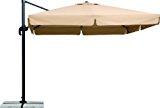


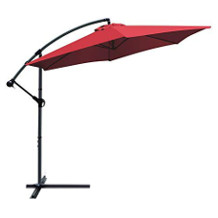
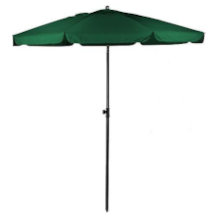
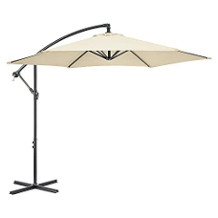
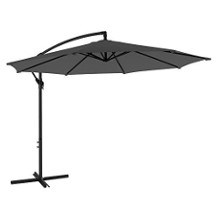
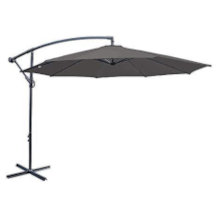
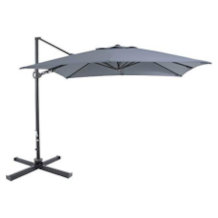





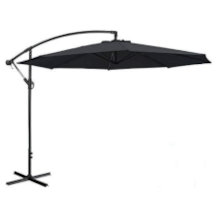
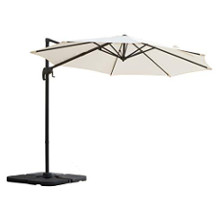
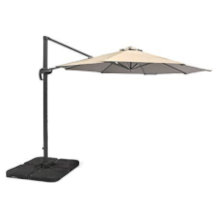
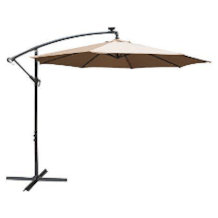
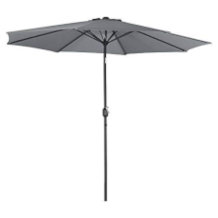
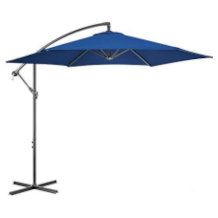
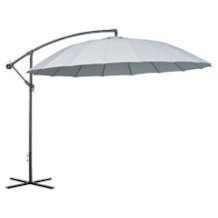

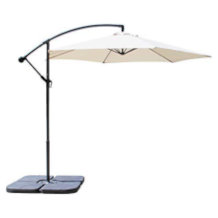


 789 reviews
789 reviews


